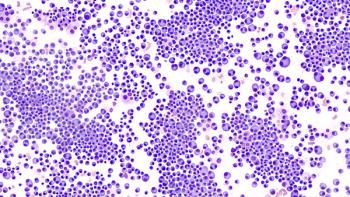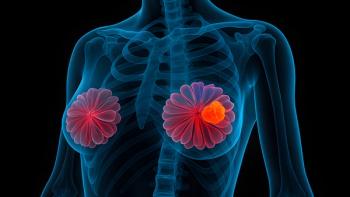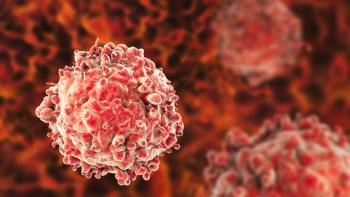
Amivantamab Plus Chemo Trends Toward Long-Term Benefit in Advanced NSCLC
Amivantamab plus chemotherapy delivered promising OS trends compared with chemotherapy in EGFR-mutant advanced non-small cell lung cancer after disease progression on osimertinib.
Amivantamab (Rybrevant) plus chemotherapy continues to trend toward better survival (OS) compared with chemotherapy alone in patients with EGFR-mutant advanced non-small cell lung cancer (NSCLC) whose disease progressed on osimertinib (Tagrisso). according to findings from the second interim analysis of the MARIPOSA-2 trial (NCT04988295).1
Results from a median follow-up of 18.1 months were presented at the 2024 ESMO Congress.
“Indeed, amivantamab’s multi-targeted mechanism of action and immune cell-directed activity, combined with chemotherapy's nonspecific anti-tumor effects, likely contributes to this observed durability,” Sanjay Popat, BSc, MBBS, FRCP, PhD, consultant medical oncologist at The Royal Marsden NHS Foundation Trust and The Institute of Cancer Research in London, said during the presentation of the data.
Amivantamab plus chemotherapy continued to demonstrate a meaningful and improved OS trend compared with chemotherapy, although it did not reach statistical significance. Patients assigned amivantamab plus chemotherapy had a median OS of 17.7 months (95% CI, 16.0-22.4) compared with 15.3 months (95% CI, 13.7-16.8) in patients assigned chemotherapy alone (HR = 0.73; 95% CI, 0.54-0.99; P = .039). OS was 50% for the amivantamab plus chemotherapy group vs 40% in the chemotherapy alone group.
“The curves separate after 6 months of follow-up and continue to separate thereafter, with an absolute survival difference of 7% at the 12-month landmark, 70% vs 63%, increasing to 10 months at the 18-month landmark of 50% vs. 40%,” Popat said. “MARIPOSA-2 is ongoing and will proceed to final overall survival analysis, as planned.”
Post-Progression Endpoints
Time to symptomatic progression (TTSP) was significantly improved in patients treated with amivantamab plus chemotherapy compared with chemotherapy, with rates at 43% and 34%, respectively. The median TTSP was 16.0 months (95% CI, 12.7-19.4) in the amivantamab plus chemotherapy group and 11.8 months (95% CI, 8.9-13.6) in the chemotherapy group (HR = 0.73; 95% CI, 0.55-0.96; P = .026). This represented a 27% reduction in the risk for symptomatic progression with amivantamab plus chemotherapy vs chemotherapy alone.
“Exploratory endpoints included time to symptomatic progression, which is clinically meaningful, as this captures not only radiographic progression, but also symptomatic progression, defined as time from randomization until deterioration of lung cancer-associated symptoms or new symptoms resulting in clinical change in systemic therapy,” Popat said.
Time to treatment discontinuation (TTD) was also significantly prolonged with amivantamab plus chemotherapy compared with chemotherapy alone (22% vs 4%, respectively).
“Time to treatment discontinuation, again, remains a meaningful endpoint in clinical practice, as this captures the additional time beyond progression of systemic therapy,” Popat said.
The median TTD was 10.4 months (95% CI, 7.9-11.6) and 4.5 months (95% CI, 4.2-5.0), respectively (HR = 0.42; 95% CI, 0.33-0.53; P < .0001).
“Indeed, at the 18-month landmark, 5-fold more patients remained on treatment with a combination of amivantamab-chemotherapy than chemotherapy alone,” Popat added.
In addition, time to subsequent therapy (TTST) was also significantly prolonged with amivantamab plus chemotherapy compared with chemotherapy alone (31% vs 12%, respectively).
“Time to subsequent therapy is an important landmark endpoint, insofar as it captures time from randomization until commencement of next line of systemic therapy in those that commence it, and is important for our reimbursement agencies,” Popat explained.
The median TTST was 12.2 months (95% CI, 10.7-14.3) in patients treated with amivantamab plus chemotherapy compared with 6.6 months (95% CI, 6.1-7.4) in those treated with chemotherapy alone (HR = 0.51; 95% CI, 0.39-0.65; P < .0001).
“TTST was 2-fold longer with the combination than chemotherapy,” Popat said.
Regarding first subsequent therapy, fewer patients in the amivantamab-chemotherapy arm had disease progression compared with the chemotherapy arm (68% vs 83%). Most patients in both groups went on to receive a subsequent therapy.
Popat noted that in both groups, there was a diversity of subsequent therapies used, including a tyrosine kinase inhibitor (TKI) combination, other TKIs, osimertinib or other third-generation TKIs, and others.
“We see that there is no clear single therapy class identified as the most prominent subsequent therapy, reiterating that most patients in this third-line setting are often re-exposed to previously used therapies, highlighting the importance of maximizing not only first but also second-line treatment duration,” he explained.
Progression-free survival after first subsequent therapy (PFS2) was significantly prolonged with amivantamab plus chemotherapy vs chemotherapy alone. At 18 months, the PFS2 rate was 39% vs 27%, respectively. The median PFS2 was 16.0 months (95% CI, 13.9-17.6) in the amivantamab plus chemotherapy arm compared with 11.6 months (95% CI, 10.1-13.0) in the chemotherapy alone arm (HR = 0.64; 95% CI, 0.48-0.85; P = .002).
Study Background
Popat explained that progression on or after TKI monotherapy is “nearly inevitable, with resistance mechanisms that can be diverse and mostly polyclonal.”
At the 2023 ESMO Congress, findings were presented that demonstrated that at a median follow-up of 8.7 months, the trial met its primary endpoint, as amivantamab plus chemotherapy significantly improved PFS compared with chemotherapy in patients with EGFR-mutant advanced NSCLC after disease progression on osimertinib (HR = 0.48; 95% CI, 0.36-0.64; P < .001).2 Combination treatment also showed a favorable trend for OS (HR = 0.77; 95% CI, 0.49-1.21) at the first interim OS analysis.
Popat noted that amivantamab plus chemotherapy is currently EMA approved and currently pending FDA approval to treat patients with EGFR-mutant advanced NSCLC after disease progression on an EGFR TKI.1
Design of the MARIPOSA-2 Trial
Patients were eligible for the MARIPOSA-2 trial if they had locally advanced or metastatic EGFR-mutated NSCLC with documented EGFR exon 19 deletion or L858R and whose disease progressed on or after osimertinib monotherapy as the most recent line of therapy. Patients also had to have good performance status, with an ECOG performance score of 0 or 1.
In this trial, 657 patients were randomized 2:1:1 to either receive amivantamab plus lazertinib (Lazcluze) and chemotherapy (n = 263), chemotherapy alone (n = 362), or amivantamab plus chemotherapy (n = 131).
“The focus of this presentation will be on the latter 2 arms, specifically chemotherapy or amivantamab-chemotherapy,” Popat explained.
Secondary/exploratory efficacy endpoints reported in this trial included OS, TTSP, TTD, TTST, and PFS2.
“The second interim overall survival analysis was prespecified when 75% of the planned overall survival events were observed,” Popat said.
For this second interim analysis for OS, the significance level was determined based on the O’Brien-Fleming alpha spending approach (2-sided alpha = 0.0142), as implemented by the Lan-DeMets method.
References
1. Popat S, Reckamp KL, Califano R, et al. Amivantamab plus chemotherapy vs chemotherapy in EGFR-mutated, advanced non-small cell lung cancer after disease progression on osimertinib: Second interim overall survival from MARIPOSA-2. Presented at: 2024 ESMO Congress; September 13-17, 2024; Barcelona, Spain. Presentation LBA54.
2. Gentzler RD, Spira A, Melosky B, et al. Amivantamab plus chemotherapy vs chemotherapy in EGFR-mutant advanced NSCLC after progression on osimertinib: a post-progression analysis of MARIPOSA-2. Ann Oncol. 2024;9(suppl 3):1-53. doi:10.1016/esmoop/esmoop102569
Newsletter
Knowledge is power. Don’t miss the most recent breakthroughs in cancer care.
















































































